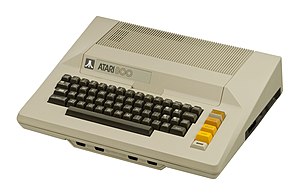Atari 8-bit

The Atari 800, featuring a full keyboard and dual-width cartridge slot cover.
|
|
| Manufacturer |
Atari, Inc. (1979–1984) Atari Corp. (1984–1992) |
|---|---|
| Type | Home computer |
| Release date | November 1979 |
| Introductory price |
US$550 (Atari 400, 1979) US$1,000 (Atari 800, 1979) |
| Discontinued | January 1992 |
| Units sold | 4 million |
| Operating system | Atari 8-bit OS |
| CPU |
MOS Technology 6502B @ 1.79 MHz (NTSC version) @ 1.77 MHz (PAL version) |
| Graphics | 384 pixels per TV line, 256 colors, 8× sprites, raster interrupts |
| Sound |
4× oscillators with noise mixing, or 2× AM digital |
| Connectivity | 2× (or 4×) Joystick, 1× Atari SIO, 1× (or 0×) PBI, 1× (or 0×) Composite Monitor,1× (or 2×) ROM cartridge |
| Successor | Atari ST |
| Related articles | Atari 5200 |
The Atari 8-bit family is a series of 8-bit home computers introduced by Atari, Inc. in 1979 and manufactured until 1992. All of the machines in the family are technically similar and differ primarily in packaging. They are based on the MOS Technology 6502 CPU running at 1.79 MHz, and were the first home computers designed with custom co-processor chips. This architecture allowed the Atari designs to offer graphics and sound capabilities that were more advanced than contemporary machines like the Apple II or Commodore PET, and gaming on the platform was a major draw. Star Raiders is widely considered the platform's killer app.
The original Atari 400 and 800 models were released with a series of plug-n-play peripherals that used Atari's "SIO" serial bus system, an early analog of the modern USB. To meet stringent FCC requirements, the early machines were completely enclosed in a solid cast aluminum block, which made them physically robust but expensive to produce. Over the following decade, the original models were replaced by the XL and XE series which had the same basic logical design, but were of much lighter construction and less expensive to build.
The Atari 8-bit computer line sold two million units during its major production run between late 1979 and mid-1985. They were not only sold through dedicated computer retailers, but department stores such as Sears, using an in-store demo to attract customers. The primary competition in the worldwide market was, starting in 1982, the Commodore 64. This was the first computer to offer similar graphics performance, and went on to be the best selling computer of the 8-bit era. Atari also found a strong market in Eastern Europe and had something of a renaissance in the early 1990s as these countries joined a uniting Europe.
...
Wikipedia
